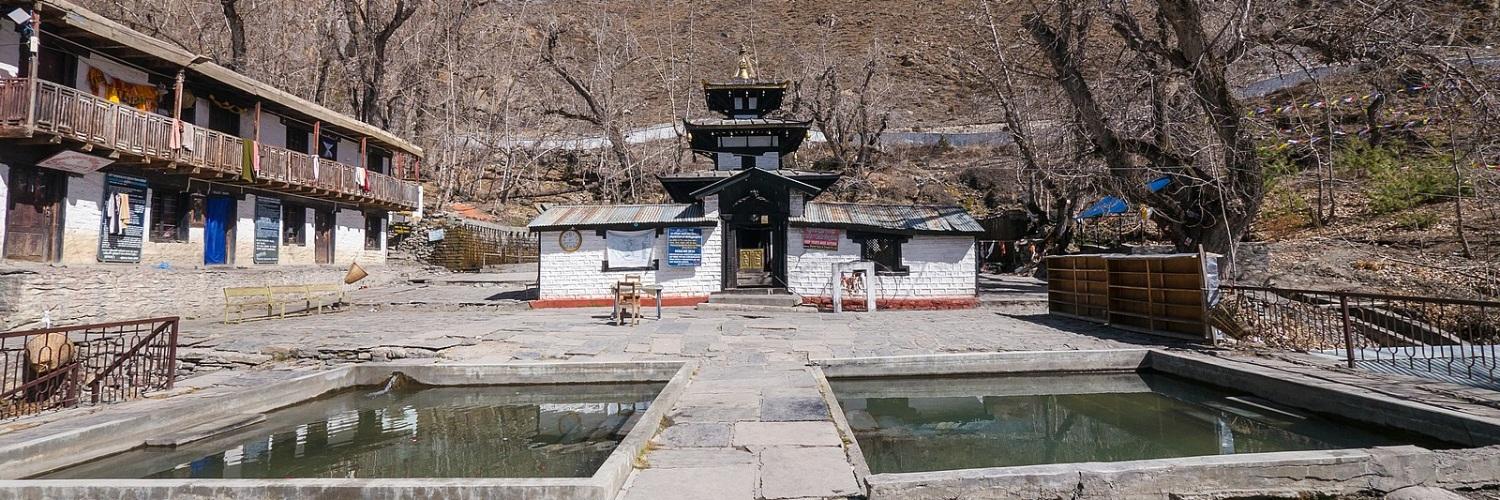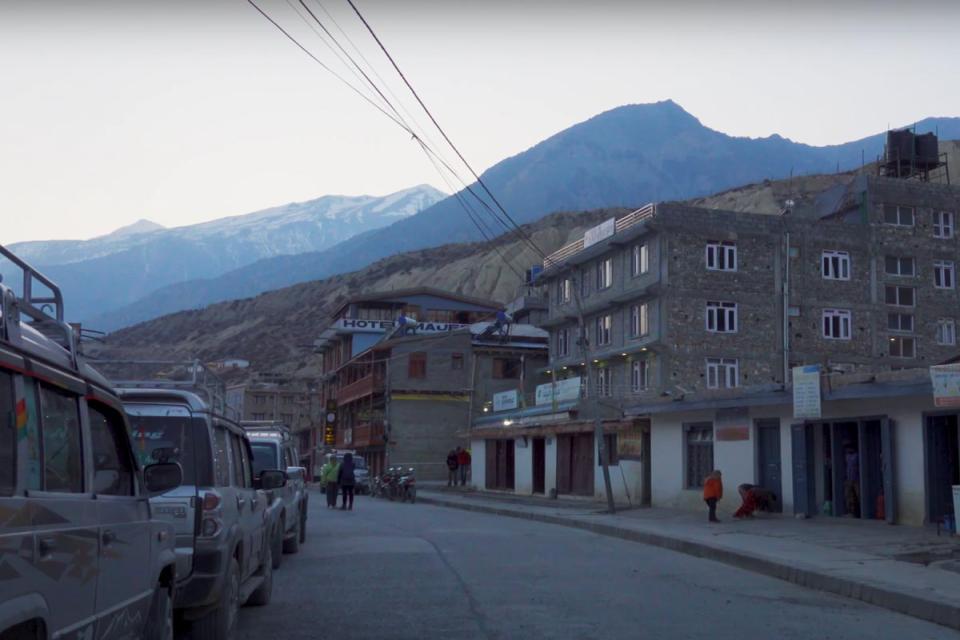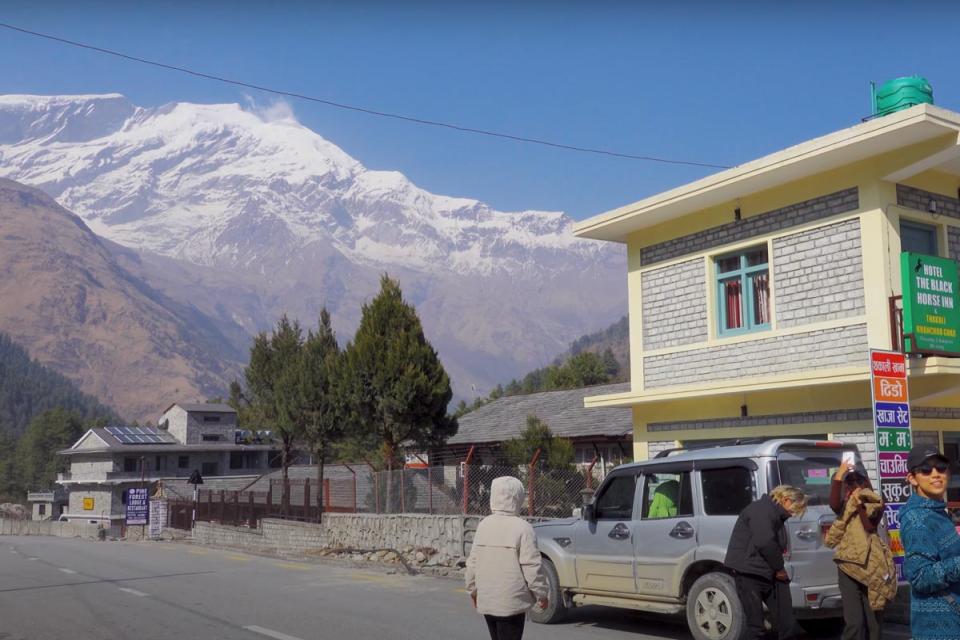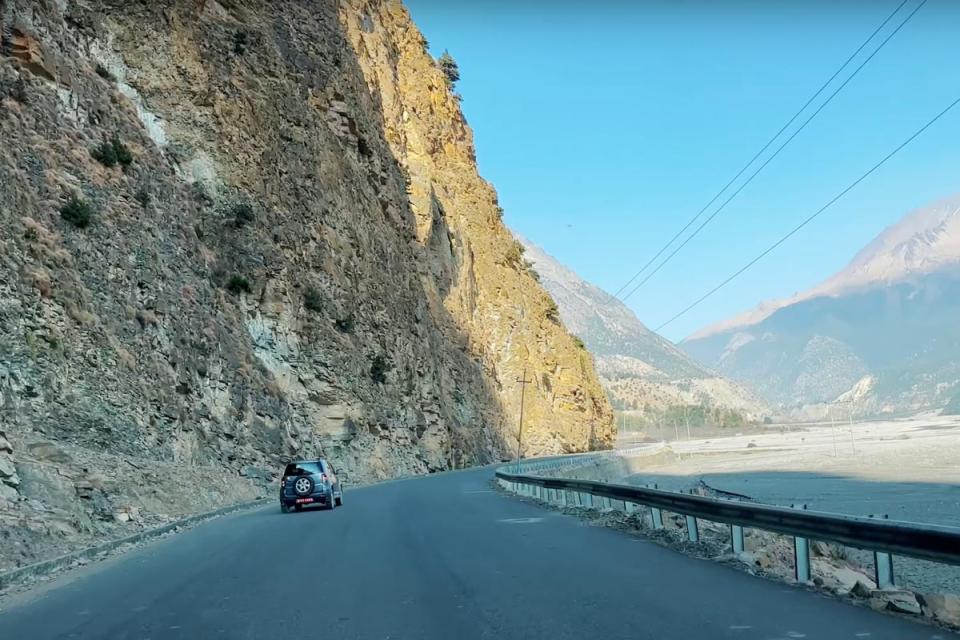Nestled in Nepal’s Mustang region, Muktinath Temple draws thousands of pilgrims and travelers each year. Perched at 3,710 meters (12,172 feet), it’s one of the world’s highest sacred sites, revered by both Hindus and Buddhists. More than a destination, Muktinath is a symbol of liberation, spiritual devotion, and harmony between faiths.
The Muktinath Temple Tour offers a unique blend of adventure and enlightenment. Whether arriving by flight, rugged Jeep routes, or trekking the Annapurna Circuit, each path reveals awe-inspiring Himalayan scenery and inner transformation. The temple itself features 108 sacred water spouts and an eternal flame, attracting seekers of purification and peace.
Surrounded by snow-capped peaks, windswept valleys, and ancient villages like Kagbeni, the region feels untouched by time. The nearby Kali Gandaki River, home to fossilized Shaligrams representing Lord Vishnu, flows through one of the world’s deepest gorges, adding natural wonder to the journey.
Whether you’re a pilgrim, trekker, or cultural explorer, the Muktinath Temple Tour promises an unforgettable experience. In this guide, discover how to plan your trip, what to expect, and why this sacred place continues to captivate all who reach its heights.
What Makes Muktinath Temple So Sacred?
Muktinath is more than a temple- it’s a symbol of moksha, or liberation, for millions of believers. Revered by both Hindus and Buddhists, Muktinath is one of the rare temples in the world where two ancient faiths intertwine harmoniously, each attributing its own sacred meanings and mythologies to this high-altitude sanctuary.
Hindu Significance: Gateway to Salvation
For Hindus, Muktinath Temple is one of the 108 Divya Desams, the holiest abodes of Lord Vishnu. The name “Muktinath” itself comes from the Sanskrit words “Mukti” meaning liberation and “Nath” meaning lord. Devotees believe that taking a pilgrimage here and bathing in the 108 ice-cold water spouts (known as Muktidhara) cleanses one’s sins and grants spiritual freedom from the cycle of rebirth.
It is also associated with the Mahabharata, as the Pandavas are said to have visited this site in their final journey toward heaven. The temple’s main deity is a golden image of Lord Vishnu, known here as Sri Muktinath or Narayana, seated in a calm meditative posture, reflecting the divine serenity of the mountains around him.
One of the most unique aspects of the site is the presence of Shaligram stones, which are found in the nearby Kali Gandaki River. These ancient ammonite fossils are considered living forms of Vishnu and are commonly worshipped in Hindu households across India and Nepal.
Buddhist Reverence: A Place of Dakinis and Transformation
For Buddhists, especially Tibetan Vajrayana practitioners, Muktinath is known as Chumig Gyatsa, meaning "Hundred Waters." It is one of the 24 tantric places of power (pithas), and is believed to be the place where the great Buddhist sage Guru Rinpoche (Padmasambhava) meditated during his travels through the Himalayas.
Buddhists associate the natural elements at Muktinath with the five elements of Tantric cosmology: earth, water, fire, air, and space. The eternal flame, burning naturally from subterranean gas near a water source, is considered a miraculous sign of balance and enlightenment. Nuns of the Tibetan Buddhist lineage often care for the temple, exemplifying the syncretic spiritual practices that flourish here.
A Rare Spiritual Intersection
This coexistence of Hindu and Buddhist practices at Muktinath offers travelers a rare spiritual intersection. It’s not just the structure of the temple, but the stories, rituals, and natural features surrounding it - like the eternal flame (Jwala Mai Temple), the 108 sacred taps, and the Shaligram stones - that create a space where spiritual seekers from different paths find common ground.
Standing in front of the temple, with prayer flags fluttering against the vast sky and mountain winds whispering through ancient stones, you feel a kind of peace that goes beyond belief systems. It is this shared sanctity that makes Muktinath Temple Tour not just a visit, but a pilgrimage for the soul.
Route Options and How to Reach Muktinath Temple
Reaching Muktinath Temple is an adventure in itself. Its remote location in the Mustang district of Nepal, near the border with Tibet, makes the journey both challenging and rewarding. Whether you're a pilgrim, a trekker, or a spiritual traveler, there are multiple ways to get to this sacred site, each offering its own unique experience. Here’s a comprehensive look at the best routes available in 2025/2026.
Option 1: Flight + Jeep Tour (Most Convenient Option)
For those short on time or preferring comfort, the most popular and time-efficient way to reach Jomsom Muktinath Temple is by combining flights and off-road Jeep travel.
Route Overview:
-
Kathmandu to Pokhara - 25-minute domestic flight
-
Pokhara to Jomsom - 15-20 minute scenic mountain flight over the Annapurna and Dhaulagiri ranges.
-
Jomsom to Muktinath - 1.5 to 2 hours by 4WD Jeep through a rugged yet scenic mountain road via Kagbeni and the Kali Gandaki Valley.
This route is especially popular with elderly pilgrims and Indian tourists who want a quicker journey without strenuous hiking. The Muktinath Temple Tour by Jeep is available year-round (except during peak monsoon months when flights are less reliable due to weather).
Option 2: Overland Tour from Kathmandu to Muktinath via Jeep
If you enjoy long road trips, you can opt for an overland Jeep journey all the way from Kathmandu to Muktinath, which usually takes 4 to 5 days one way.
Route Details:
- Kathmandu → Pokhara → Tatopani → Jomsom → Kagbeni → Muktinath
This route covers long stretches of rugged, off-road terrain and is suitable for those who love remote travel. It's more budget-friendly than flights but requires patience and stamina due to unpredictable road conditions.
Option 3: Helicopter Tour to Muktinath (Luxury Experience)
For those with limited time or seeking a once-in-a-lifetime Himalayan experience, a Muktinath Helicopter Tour is the most luxurious and scenic option. You can charter a helicopter from Kathmandu or Pokhara directly to Muktinath.
-
Flight Time: ~1 hour from Pokhara / 1.5 hours from Kathmandu
-
Highlights: Aerial views of Annapurna, Dhaulagiri, Kali Gandaki Gorge, and landing near the temple for quick darshan.
Though expensive, it’s perfect for VIP travelers, elderly pilgrims, or special occasions like anniversaries or spiritual milestones.
Travel Permits Required
To enter the Mustang region, both foreign and Indian tourists need two permits:
-
ACAP (Annapurna Conservation Area Permit) - NPR 3,000 (~USD 25)
-
TIMS (Trekkers' Information Management System Card) - NPR 2,000 (~USD 15) or NPR 1,000 for group trekkers
These are checked at multiple entry points along the route and can be arranged in Kathmandu or Pokhara through authorized agencies or with Best Heritage Tour.
Each route to Muktinath Temple offers its own blend of adventure, culture, and serenity. Whether you prefer the skies or the roads, the journey itself becomes an essential part of the pilgrimage enhancing the spiritual fulfillment when you finally stand before the sacred shrine.
Jomsom, Kagbeni, and the Kali Gandaki Valley: Exploring the Sacred Landscape
Before you even reach Muktinath Temple, the land you traverse is rich with myth, meaning, and majesty. The trail takes you through a stunning and sacred corridor: Jomsom, Kagbeni, and the mystical Kali Gandaki Valley. These are not just stops along the route - they are powerful destinations in their own right, each offering insights into the region’s spiritual and cultural fabric.
Jomsom: Gateway to the Divine
Jomsom, a bustling Himalayan town perched at 2,743 meters, serves as the administrative and logistical hub of the Mustang region. Flanked by the soaring Nilgiri Himal to the east and the rugged Kali Gandaki riverbed to the west, Jomsom offers the first glimpse of the barren, windswept beauty of the trans-Himalayan landscape.
Here, trekkers and pilgrims catch their breath, stock up on essentials, and acclimatize before heading to higher altitudes. The town has a small airport, cozy teahouses, and modern amenities, making it a crucial rest point. It’s also a cultural melting pot - home to Thakali, Tibetan, and Hindu communities who live in harmony and celebrate a variety of mountain festivals year-round.
The dry, breezy climate and high-altitude desert surroundings of Jomsom create a stark contrast to the lush greenery of Pokhara or Kathmandu. As you breathe in the thin, pure air, you begin to feel the spiritual shift - the calm before entering one of the holiest regions in Nepal.
Kagbeni: Ancient Village at the Edge of Time
Just a 30-40-minute drive from Jomsom lies Kagbeni, a timeless village located at the junction of the Upper Mustang and Lower Mustang regions. This windswept settlement, with its red mud-brick houses, fluttering prayer flags, and maze-like alleys, feels like stepping into a medieval Tibetan world.
Kagbeni is not only visually arresting but spiritually profound. It houses one of the oldest Buddhist monasteries in Mustang and is deeply associated with death rituals in Hinduism. Many Hindus come here to perform Shraddha (ancestral rites) along the riverbanks, believing it helps the departed attain moksha.
The fusion of Tibetan Buddhist culture and ancient Hindu practices makes Kagbeni a spiritual crossroad. Monks chant prayers in ancient gompas, while pilgrims release flower offerings into the Kali Gandaki River. You may also find Shaligram stones along the riverbanks - fossils believed to be manifestations of Lord Vishnu, adding to the sacredness of this ancient land.
Kali Gandaki: The Sacred River of Shaligrams
Flowing through one of the world’s deepest gorges between Annapurna and Dhaulagiri, two 8,000-meter peaks - the Kali Gandaki River is no ordinary Himalayan stream. It is known as the black river, named after the goddess Kali, and is revered in both Hindu and Buddhist traditions.
This mighty river is the only known source of Shaligrams, sacred fossilized ammonites that are worshipped as direct embodiments of Vishnu. Pilgrims often scour the riverbed in hopes of finding these powerful symbols, which are kept in home altars or temples throughout the Hindu world.
Aside from its religious importance, the Kali Gandaki is also a lifeline for Mustang’s ancient trade routes and remote communities. Walking along its riverbanks, with the sound of the water mingling with prayer flags flapping in the wind, one can’t help but feel a deep connection to the sacred rhythms of nature.
The Spiritual Synergy of the Landscape
From Jomsom's rugged calm to Kagbeni’s sacred silence, and through the myth-laden currents of Kali Gandaki, the approach to Muktinath Temple is unlike any other. These locations are more than geographical markers - they are places of personal reflection, deep prayer, and awe-inspiring beauty.
As you journey through this divine corridor, you're not just walking across landscapes - you’re traveling through layers of myth, spirit, and time.
The Muktinath Temple Complex: Sacred Sites, Rituals, and Spiritual Symbolism
Perched at an altitude of 3,710 meters (12,172 ft) in the desolate yet divine landscapes of Upper Mustang, Muktinath Temple is not just a structure - it’s a living embodiment of spiritual liberation. Known as Mukthi Kshetra (Place of Salvation), this temple draws Hindus, Buddhists, and spiritual seekers from around the world, all seeking blessings, peace, and a connection with the eternal.
What makes Muktinath truly unique is not just its elevation or its location - but the deep interfaith harmony, ancient rituals, and natural elements that make this place sacred to multiple religious traditions.
A Shared Pilgrimage for Hindus and Buddhists
For Hindus, Muktinath is one of the 108 Divya Desams, sacred Vishnu temples mentioned in the ancient Tamil canon. Lord Vishnu is worshipped here as Sri Muktinath, the giver of moksha (liberation from the cycle of rebirth). Devotees believe that a visit here cleanses lifetimes of sin and paves the way for salvation.
For Buddhists, Muktinath is a sacred site of the Chumig Gyatsa - “Hundred Waters” in Tibetan. They believe the temple is inhabited by Dakinis, goddess-like beings, and is a site visited and blessed by Padmasambhava (Guru Rinpoche) during his journey to Tibet.
This confluence of traditions creates a powerful spiritual energy at Muktinath, making it one of the few places in the world where Buddhist monks and Hindu priests perform rituals side by side.
The Main Temple: Symbol of Eternal Liberation
The main shrine is a small pagoda-style temple made of stone and brass, encased in a serene courtyard. It is modest in size, but monumental in significance. Inside resides the idol of Lord Vishnu, flanked by the deities of Lakshmi, Saraswati, Janaki, Garuda, Lava, and Kusha.
Pilgrims offer flowers, lamps, and water while chanting prayers. The atmosphere is quiet, mystical, and deeply reverent. Devotees circumambulate the temple in a clockwise direction, feeling the thin mountain air as both a physical and spiritual purification.
Despite its remote location and minimalist structure, the aura of divinity here is palpable - many describe a sense of stillness and transcendence that cannot be captured in words.
108 Sacred Water Spouts: Ritual of Purification
Perhaps the most iconic feature of Muktinath is the 108 water spouts (called Muktidhara) arranged in a semi-circle behind the temple. These waters, gushing from stone bull heads (muktimukhas), are sourced from glacial springs and represent the 108 sacred names of Lord Vishnu.
Taking a ritual bath under all 108 spouts - even in the bone-chilling Himalayan cold is believed to wash away all sins and purify the soul. Many pilgrims perform this act with devotion, trembling from the cold but glowing with inner peace.
Some also dip into the nearby two holy kundas (water ponds) before entering the temple, completing the ritual purification required before darshan (sacred viewing).
Eternal Flame of Muktinath: Jwala Mai Temple
Just a few minutes’ walk downhill from the main shrine lies the Jwala Mai Temple, a sacred natural phenomenon and a highlight of the Muktinath Temple Tour.
Here, a small flame burns eternally from a crack in the earth, sustained by natural gas. It flickers above water - a rare convergence of earth, fire, water, and air in a single place. This is interpreted as the divine presence of the goddess and is revered in both Hindu and Buddhist teachings.
Pilgrims offer butter lamps, incense, and prayers here, seeking blessings for strength, transformation, and inner awakening.
Symbolism and Spiritual Power of the Complex
Every corner of the Muktinath Temple complex is rich with layers of meaning:
-
The 108 waterspouts represent cosmic completeness.
-
The eternal flame signifies divine truth that transcends time.
-
The coexistence of Buddhist and Hindu rituals reflects universal unity and tolerance.
-
The altitude and environment serve as metaphors for spiritual ascension - closer to the gods and freer from worldly distractions.
Many spiritual travelers report that the air at Muktinath feels “lighter” and the mind, clearer. Whether you're a believer or simply a seeker, the temple acts as a gateway to a higher state of awareness.
Pilgrimage Experience: A Personal Journey
For most, the visit to Muktinath is not just about religious rituals - it’s a deeply personal pilgrimage. Some come to fulfill vows, some to seek healing, and others to honor their ancestors. Regardless of intent, few leave unchanged.
The serenity of the temple, set against the backdrop of snow-capped peaks, dusty trails, and fluttering prayer flags, leaves a lasting impression - spiritual or otherwise.
Conclusion: Embark on Your Spiritual Journey to Muktinath Temple
Visiting the Muktinath Temple is much more than just a travel experience - it is a profound spiritual journey set against the backdrop of Nepal’s majestic Himalayas. Whether you arrive by jeep, flight, or on foot through the ancient trails of Kagbeni and the Kali Gandaki Valley, the pilgrimage offers a unique blend of natural beauty, cultural richness, and religious significance that leaves every traveler transformed.
From the tranquil prayers echoing through the temple’s sacred halls to the breathtaking panoramic views of Annapurna and Dhaulagiri peaks, every moment at Jomsom Muktinath Temple invites reflection, reverence, and renewal. The path itself - traversing diverse landscapes from lush valleys to arid highlands - mirrors the spiritual quest for enlightenment and liberation that the temple represents.
Whether you seek the blessings of Lord Vishnu, want to immerse yourself in the sacred Hindu-Buddhist traditions, or simply desire an escape into Nepal’s mystical highlands, the Muktinath Temple Tour promises an unforgettable adventure for every traveler.
Ready to Begin Your Pilgrimage?
Plan your trip wisely, choose the best season for your journey, and budget according to your travel style. For a hassle-free, authentic experience with expert guidance and personalized service, Best Heritage Tour stands ready to assist you at every step.
Take the first step towards a life-changing journey - contact Best Heritage Tour today and let your spiritual odyssey to Muktinath begin!
Contact Best Heritage Tour
Website: www.bestheritagetour.com
Email: info@bestheritagetour.com
Phone/WhatsApp/Viber: +977-9851149197
Author: Best Heritage Tour
Date: 20th June, 2025




